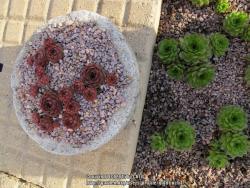I have heard various opinions on how sunshine affects Sempervivum coloration. I'm not too sure so I thought we could crowdsource this. I don't need facts or evidence, just your opinions based on your experience. It seems to me that semps are healthy with a half day of sun or a full day in a reasonably semp-friendly climate. (Sorry, Southerners)
But which is better for color?
Or is there no difference?
Is it different between Sempervivum vs. Heuffelii?
Is it different between color schemes? (reds vs yellows vs purples vs greens)
Or is it different based on individual cultivar?
My own unfounded opinion that more sunshine is better, but I don't really know.
Here is 'Michaels Golden' not looking very golden. But it
is November and he is actually a very lovely bright, jade color. But I wonder if moving him to the sunnier part of my semp garden will bring out his golden potential next season. Maybe I'll just move some of his offsets and compare them next summer.


